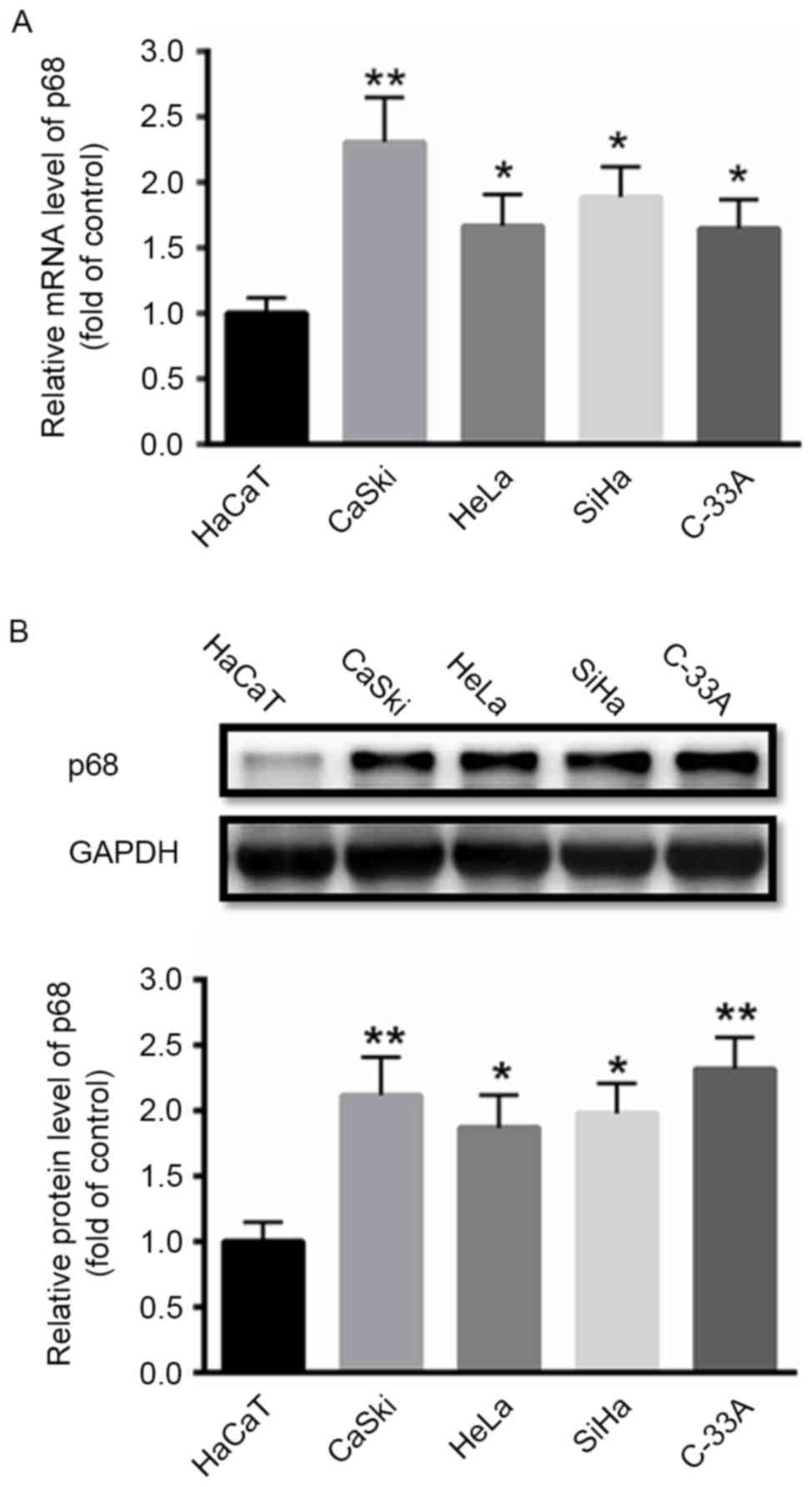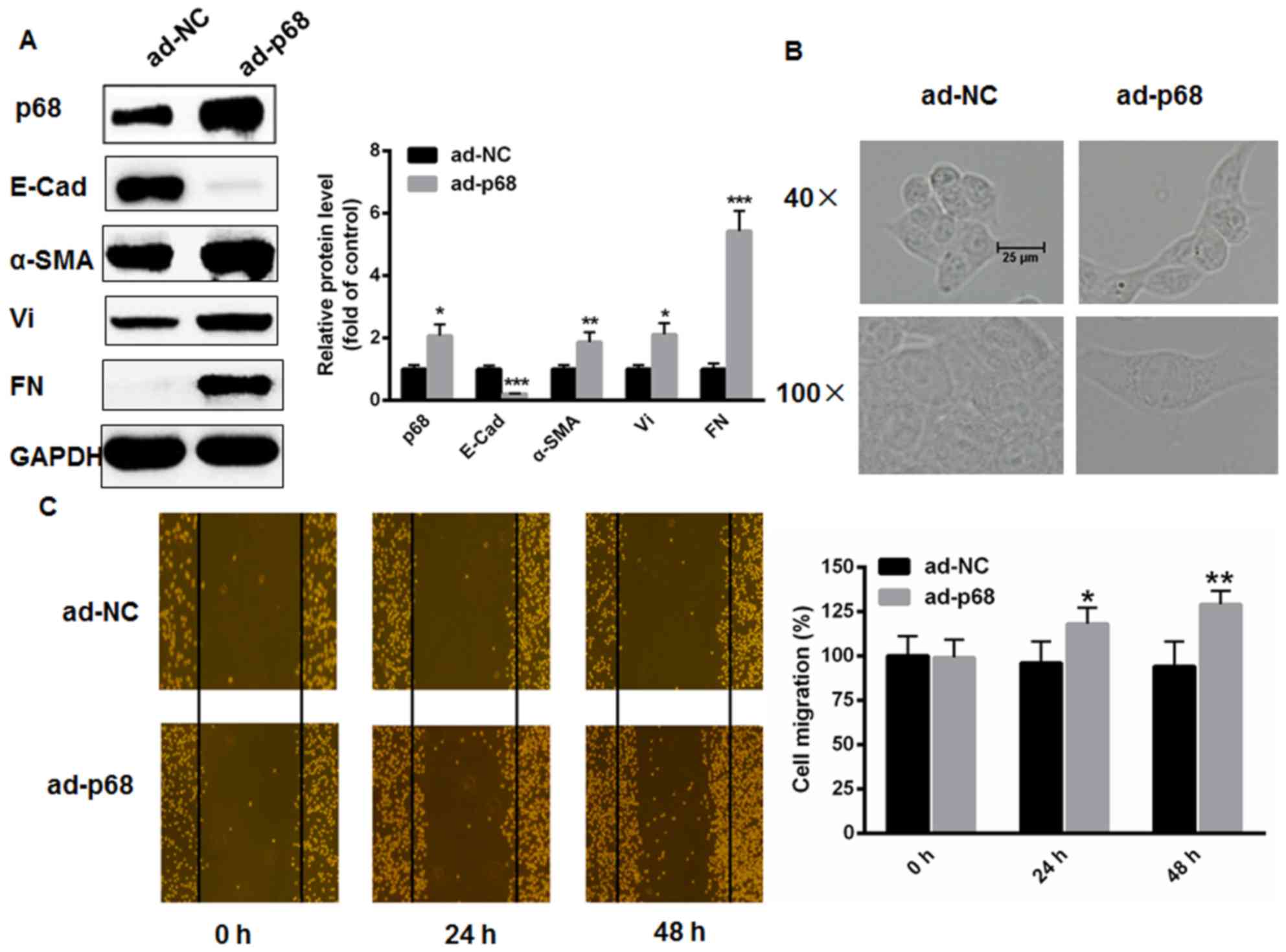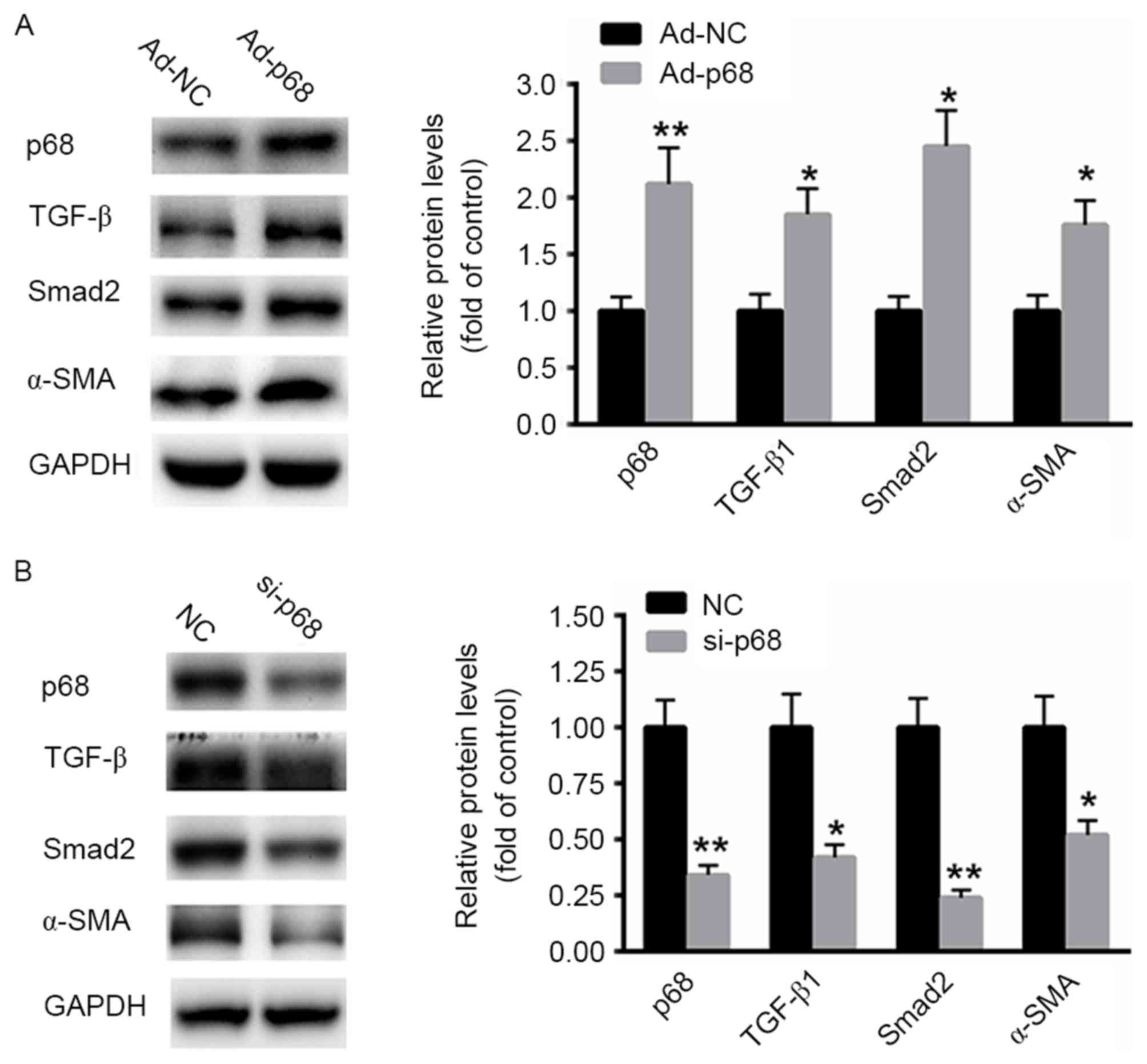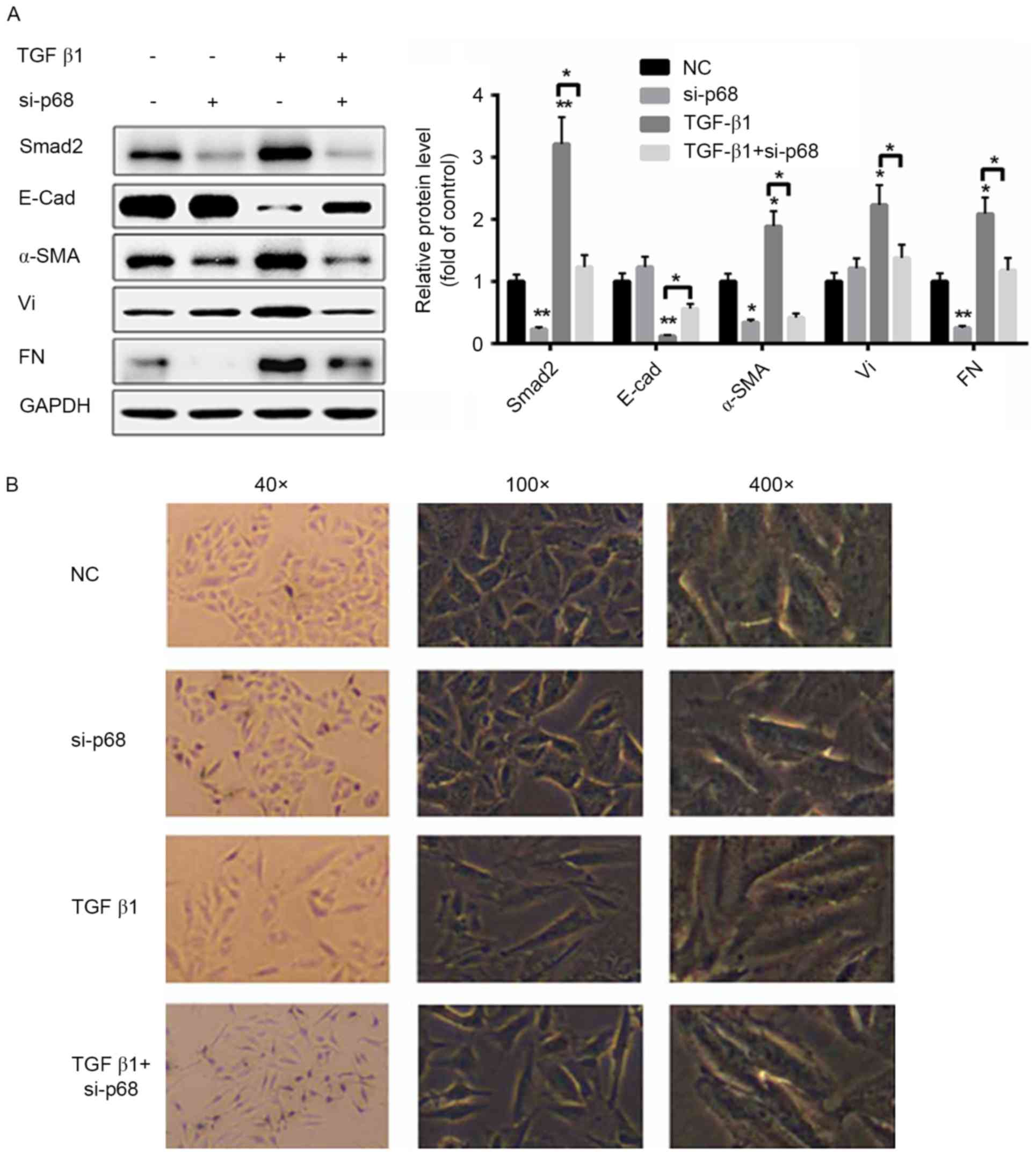p68 prompts the epithelial‑mesenchymal transition in cervical cancer cells by transcriptionally activating the TGF‑β1 signaling pathway
Retraction in: /10.3892/ol.2024.14708
- Authors:
- Published online on: December 8, 2017 https://doi.org/10.3892/ol.2017.7552
- Pages: 2111-2116
-
Copyright: © Li et al. This is an open access article distributed under the terms of Creative Commons Attribution License.
Abstract
Introduction
Cervical cancer is the third-leading cause of cancer-associated mortality among young women worldwide; it is a severe health threat in developing countries, which is often caused by a persistent infection with the human papillomavirus (HPV) (1,2). However, owing to an increased rate of tumor recurrence and metastasis, there are no sufficient treatment options at present other than surgical resection.
The primary cause of cancer-associated mortality is due to the fact that tumor cells are able to disseminate to distant sites (3,4). However, the mechanism by which metastasis occurs remains controversial. Studies have indicated that the epithelial-mesenchymal transition (EMT) is a necessary prerequisite for tumor metastasis (5–7). Owing to the clinical importance of metastasis, a number of studies have focused on elucidating the mechanisms of EMT (8,9). Transforming growth factor-β1 (TGF-β1) serves a key role in the process of EMT and is regarded as a driver of EMT (10,11). However, the mechanisms underlying the regulation of TGF-β1 in cervical cancer cells remain elusive.
Probable adenosine triphosphate (ATP)-dependent RNA helicase DDX5 (also known as p68) was initially identified through immunological cross-reactivity against the anti-simian virus 40 large T-monoclonal antibody (12). It has been reported that p68 knockout mice are embryonically lethal (embryonic day, 11.5), indicating that it serves a key function in the developmental process (13). p68 is involved in the processing of RNA secondary structures, which participates in a variety of biological processes, including cell proliferation and organ differentiation (14–16). At present, p68 has been identified to activate the transcription of estrogen receptor, androgen receptor and tumor suppressor p53, myoblast determination protein and β-catenin (16,17). Overexpression of p68 has been documented in various types of cancer including colon, breast and prostate cancer (18–20). However, to the best of our knowledge, no study has been conducted on the specific role of p68 in cervical cancer.
In the present study, the expression and potential mechanism of p68 in the development of cervical cancer was investigated. To the best of our knowledge, for the first time, it was demonstrated that p68 was markedly upregulated in cervical cancer cells. Furthermore, it was demonstrated that p68 may transcriptionally activate the expression of TGF-β1, thereby prompting the EMT process of cervical cancer cells.
Materials and methods
Cell culture
The cervical cancer CaSki, HeLa (HPV-18-positive), SiHa (HPV-16-positive) and C-33A (HPV-negative) cell lines were compared with the human keratinocyte cell HaCaT line and obtained from the American Type Culture Collection (Manassas, VA, USA) and cultured in RPMI-1640 (GE Healthcare Life Sciences, Little Chalfont, UK). All cultures were supplemented with 10% fetal bovine serum (Invitrogen; Thermo Fisher Scientific, Inc., Waltham, MA, USA), streptomycin (100 mg/ml; GE Healthcare Life Sciences) and penicillin (100 IU/ml; GE Healthcare Life Sciences) at 37°C in a humidified atmosphere containing 5% CO2.
Small interfering RNA (siRNA)transfection
The p68 siRNA oligonucleotide was purchased from Shanghai GenePharma Co., Ltd. (Shanghai, China); the sequence was 5′-GCUGAAUAUUGUCGAGCUU-3′. Briefly, CaSki cells were seeded at 1×106 cells/well in the 6-well plates in the presence or absence of 20 nM TGF-β. The p68-siRNA or a non-specific negative control (NC) siRNA (5′-TTCTCCGAACGTGTCACGT-3′) were mixed with HiperFect transfection reagent at a final concentration of 50 nM (Qiagen, Inc., Valencia, CA, USA) and incubated at room temperature for 10 min. Next, the complex was added to the culture medium of cells for 48 h, after which the subsequent experiments were conducted.
RNA extraction and reverse transcription-quantitative polymerase chain reaction (RT-qPCR)
The total RNA from cultured cells was isolated using TRIzol (Invitrogen; Thermo Fisher Scientific, Inc., Waltham, MA, USA) according to the manufacturer's protocol. The total RNA was reverse transcribed at 72°C for 10 min and 42°C for 60 min into cDNA with TaqMan RNA Reverse Transcription kit (Applied Biosystems; Thermo Fisher Scientific, Inc.). qPCR was performed using SYBR-Green Supermix (Bio-Rad Laboratories, Inc., Hercules, CA, USA) in a BIO-RAD iCycleriQ real-time PCR detection system, as described previously (21). Details of PCR procedures were as follows: 95°C for 10 min followed by 50 cycles of 95°C for 10 sec, 55°C for 10 sec, 72°C for 5 sec, 99°C for 1 sec, 59°C for 15 sec, 95°C for 1 sec. The primers used were listed as follows: p68 forward, 5-AGAGGTTCAGGTCGTTCCAGG-3 and reverse, 5-GGAATATCCTGTTGGCATTGG-3; GAPDH forward, 5-CACCCAGAAGACTGTGGATGG-3 and reverse, 5-GTCTACATGGCAACTGTGAGG-3. Relative mRNA expression was normalized against the endogenous control, GAPDH, using the 2−ΔΔCq method (22).
Protein extraction and western blot analysis
Proteins samples were extracted in RIPA buffer (1% TritonX-100, 15 mmol/l NaCl, 5 mmol/l EDTA, and 10 mmol/l Tris-HCl; pH 7.0; Beijing Solarbio Science and Technology Co., Ltd., Beijing, China) supplemented with a protease and phosphatase inhibitor cocktail (Sigma-Aldrich; Merck KGaA, Darmstadt, Germany) and then 20 µg protein loaded per lane was separated by SDS-PAGE (10% gel), followed by electrophoretic transfer to a polyvinylidene fluoride membrane. Following incubation with 8% non-fat milk in PBST (pH 7.5) for 2 h at room temperature, membranes were incubated with the following primary antibodies: Antibodies against decapentaplegic homolog 2 (Smad2; 1:1,000; cat. no. #8685; Cell Signaling Technology, Inc., Danvers, MA, USA), anti-E-cadherin (1:1,000; cat. no. 3199; Cell Signaling Technology, Inc.), anti-α-smooth muscle actin (α-SMA; 1:1,000; cat. no. 19245; Cell Signaling Technology, Inc.), fibronectin (FN; 1:1,000; cat. no. ab2413; Abcam, Cambridge, UK), vimentin (Vi; 1:1,000; cat. no. 5714; Cell Signaling Technology, Inc.) and anti-GAPDH (1:1,000; cat. no. 5174; Cell Signaling Technology, Inc.). Following several washes with TBST, the membranes were incubated with HRP-conjugated goat anti-rabbit IgG (1:5,000; cat. no. ZB-2306; Zhongshan Gold Bridge Biological Technology Co., Beijing, China) for 2 h at room temperature and then washed. Immunodetection was performed by enhanced chemiluminescence detection system (EMD Millipore, Billerica, MA, USA) according to the manufacturer's protocol. The housekeeping gene GAPDH was used as the internal control. The protein levels were quantified using density analysis according to the manufacturer's protocol (ImageJ version 1.8.0; National Institutes of Health, Bethesda, MD, USA).
Adenoviral vector construction and transfection
Recombinant adenoviruses expressing p68 (ad-p68) or a negative control adenovirus vector containing green fluorescent protein (ad-NC) were purchased from Shanghai GeneChem Co., Ltd. (Shanghai, China). In brief, CaSki cells were seeded at 1×106 cells/well in 6-well plates. After 24 h, the ad-p68 or ad-NC vectors were transfected into the cells at a multiplicity of infection of 25 and the cells were collected 48 h later for experimentation.
Migration assay
Cell migration was assessed using in vitro scratch assays. Firstly, cells were cultured at 1×105 cells/well in 12-well plates for 24 h. Next, a 10 µ1 pipette tip was used to create an artificial gap in the confluent cell monolayer. Following transfection with ad-P68 or ad-NC for 48 h, the cells were washed with pre-warmed PBS three times to remove the debris. The initial images of the scratch (0 h) and final images of the scratch (48 h) were captured with an inverted light microscope. The migratory abilities were quantified by measuring the area of the scratched regions using the ImagePro Plus 4.5 software (Media Cybernetics, Inc., Rockville, MD, USA).
Observation of cell morphology
In brief, CaSki cells were cultured at 1×105 cells/well in 12-well plates for 24 h. Then, the cells were transfected with ad-P68 or ad-NC for 48 h, the cells were washed with pre-warmed PBS three times to remove the debris. Subsequently, cell morphology was observed under an inverted light microscope (magnification, ×400).
Statistical analysis
Data are presented as the mean ± standard deviation following 3 independent experiments. SPSS (version 13.0; SPSS, Inc., Chicago, IL, USA) was used to perform statistical analyses. Two-tailed unpaired Student's t-tests were used for comparisons of two groups. Analysis of variance followed by Turkey's post hoc test was used for comparisons of two more groups. P<0.05 was considered to indicate a statistically significant difference.
Results
Upregulation of p68 in cervical cancer cells
First, the expression of p68 was investigated in cervical cancer cells. RT-qPCR and western blot analyses demonstrated that the mRNA and protein levels of p68 were significantly enhanced in cervical cancer CaSki, HeLa, SiHa, and C-33A cell lines compared with a human keratinocyte HaCaT cell line (Fig. 1).
p68 enhances EMT in CaSki cells
The effect of p68 on the process of EMT in CaSki cells, which serves a key function in cancer cell migration, was investigated. First, ad-p68 or ad-NC was transfected into CaSki cells. At 48 h later, western blot analysis demonstrated that transfection with ad-p68 significantly enhanced the protein expression of p68 compared with NC-treated cells. Furthermore, overexpression of p68 induced the expression of the mesenchymal markers α-SMA, vimentin and fibronectin, whereas the epithelial marker E-cadherin was significantly decreased (Fig. 2A). CaSki cells exhibited an elongated and spindle-shaped morphology following transfection with ad-p68 (Fig. 2B). In addition, the role of p68 on CaSki cell migration was also investigated. As presented in Fig. 2C, the in vitro scratch assay demonstrated that overexpression of p68 markedly enhanced CaSki cell migratory capacity at 24 and 48 h (Fig. 2C).
p68 stimulates the expression of TGF-β1 in CaSki cells
Next, ad-p68 was transfected into CaSki cells for 48 h. Western blot analysis revealed that overexpression of p68 significantly enhanced the expression TGF-β1 (Fig. 3A). Expression of downstream effectors, including Smad2 and α-SMA, was also significantly upregulated (Fig. 3A). By contrast, silencing of p68 with a specific siRNA significantly suppressed the protein expression of TGF-β1 as well as the downstream effectors Smad2 and α-SMA compared with the NC siRNA (Fig. 3B). These data indicated that p68 stimulates the expression of TGF-β1, inducing downstream signaling in CaSki cells.
Silence of p68 partially abolishes TGF-β1-induced EMT process in CaSki cells
To determine whether p68 prompts the EMT process in CaSki cells by stimulating TGF-β1 expression, CaSki cells with siRNA-p68, TGF-β1, either alone or together. Silencing of p68 significantly suppressed the TGF-β1 signaling pathway. By comparison, treatment with TGF-β1 markedly activated the TGF-β1 signaling pathway, including upregulation of Smad2, α-SMA, FN, Vi and downregulation of E-cad (Fig. 4A). Notably, knockdown of p68 partially reversed TGF-β1-treatment-induced changes to the expression of EMT markers (Fig. 4A). The morphological changes of CaSki cells were also determined. As presented in Fig. 4B, TGF-β1-induced cell morphological changes, including elongated and spindle-shaped morphology, were partially reversed by knockdown of p68. These data indicated that p68 prompted CaSki cell malignancies, primarily by stimulating the expression of TGF-β1.
Discussion
Cervical cancer is the third most common type of cancer among females worldwide (1,2). At present, the treatment outcome for cervical cancer is unsatisfactory, particularly when advanced-stage tumors are considered. It is widely accepted that tumor metastases accounts for ~90% of all cancer-associated mortalities (23). Therefore, identification of the causes of metastasis may assist in the development of novel treatment methods for patients with cervical cancer, and therefore research in this field is of great importance.
p68 belongs to the Asp-Glu-Ala-Asp (DEAD)-box family of RNA helicases, with a conserved DEAD peptide sequence. This family is reported to modulate RNA structure through its ATP-dependent RNA helicase activity (24). Studies have demonstrated that DEAD-box-containing proteins serve a key role in ribosome biogenesis, embryogenesis and cell division (25–27). Previous studies revealed that p68 activates the expression of several oncogenes, thereby modulating cancer growth and metastasis (24,28). It is reported that the upregulation of p68 serves a key function in cancer progression, particularly in breast cancer (29). The present study investigated the expression of p68 in cervical cancer cells, determining that the expression of p68 was significantly increased in cervical cancer CaSki, HeLa, SiHa and C-33A cell lines, compared with a human keratinocyte HaCaT cell line at the transcriptional and post-transcriptional levels. These results demonstrated the oncogenic role of p68 in cervical cancer cells.
TGF-β1 signaling serves a key function in tissue homeostasis and cancer progression (30). It is reported that activation of TGF-β1 signaling contributes to an abnormal EMT process (10). However, whether p68 regulates the EMT process has, to the best of our knowledge, never been investigated. The present study identified that overexpression of p68 significantly enhanced the expression of TGF-β1, thereby contributing to the EMT process in cervical cancer cells. In line with these observations, transfection with ad-p68 induced morphological changes inhuman cervical cancer cells. TGF-β1 is considered to be a primary driver of EMT processes and tumor progression. Results reported in the present study determined that p68 is able to activate TGF-β1 production and downstream signaling.
To the best of our knowledge, this is the first study demonstrating that inhibition of p68 reverses TGF-β-induced EMT in cervical cancer cells by inactivating TGF-β1 signaling. The results of the present study revealed that silencing of p68 inhibits cell proliferation and reverses EMT. These results provide novel mechanistic insight into the pro-tumor effects of p68 in cervical cancer cells.
Acknowledgements
The present study was supported by Science and Technology Planning Project of Guangdong Province, China (grant no. 2014A020212345) and Medical Science Research Foundation of Guangdong Province, China (grant no. C2015038).
References
|
Kim M, Kim YS, Kim H, Kang MY, Park J, Lee DH, Roh GS, Kim HJ, Kang SS, Cho GJ, et al: O-linked N-acetylglucosamine transferase promotes cervical cancer tumorigenesis through human papillomaviruses E6 and E7 oncogenes. Oncotarget. 7:44596–44607. 2016. View Article : Google Scholar : PubMed/NCBI | |
|
Ferlay J, Soerjomataram I, Dikshit R, Eser S, Mathers C, Rebelo M, Parkin DM, Forman D and Bray F: Cancer incidence and mortality worldwide: Sources, methods and major patterns in GLOBOCAN, 2012. Int J Cancer. 136:E359–E386. 2015. View Article : Google Scholar : PubMed/NCBI | |
|
Caramel J, Papadogeorgakis E, Hill L, Browne GJ, Richard G, Wierinckx A, Saldanha G, Osborne J, Hutchinson P, Tse G, et al: A switch in the expression of embryonic EMT-inducers drives the development of malignant melanoma. Cancer Cell. 24:466–480. 2013. View Article : Google Scholar : PubMed/NCBI | |
|
Fenouille N, Tichet M, Dufies M, Pottier A, Mogha A, Soo JK, Rocchi S, Mallavialle A, Galibert MD, Khammari A, et al: The epithelial-mesenchymal transition (EMT) regulatory factor SLUG (SNAI2) is a downstream target of SPARC and AKT in promoting melanoma cell invasion. PLoS One. 7:e403782012. View Article : Google Scholar : PubMed/NCBI | |
|
Jiang GM, Xie WY, Wang HS, Du J, Wu BP, Xu W, Liu HF, Xiao P, Liu ZG, Li HY, et al: Curcumin combined with FAPαc vaccine elicits effective antitumor response by targeting indolamine-2,3-dioxygenase and inhibiting EMT induced by TNF-α in melanoma. Oncotarget. 6:25932–25942. 2015. View Article : Google Scholar : PubMed/NCBI | |
|
Jung HY, Fattet L and Yang J: Molecular pathways: Linking tumor microenvironment to epithelial-mesenchymal transition in metastasis. Clin Cancer Res. 21:962–968. 2015. View Article : Google Scholar : PubMed/NCBI | |
|
Zhang P, Sun Y and Ma L: ZEB1: At the crossroads of epithelial-mesenchymal transition, metastasis and therapy resistance. Cell Cycle. 14:481–487. 2015. View Article : Google Scholar : PubMed/NCBI | |
|
Laurenzana A, Biagioni A, Bianchini F, Peppicelli S, Chillà A, Margheri F, Luciani C, Pimpinelli N, Del Rosso M, Calorini L and Fibbi G: Inhibition of uPAR-TGFβ crosstalk blocks MSC-dependent EMT in melanoma cells. J Mol Med (Berl). 93:783–794. 2015. View Article : Google Scholar : PubMed/NCBI | |
|
Lin K, Baritaki S, Militello L, Malaponte G, Bevelacqua Y and Bonavida B: The role of B-RAF mutations in melanoma and the induction of EMT via DYsregulation of the NF-κB/Snail/RKIP/PTEN circuit. Genes Cancer. 1:409–420. 2010. View Article : Google Scholar : PubMed/NCBI | |
|
Schlegel NC, von Planta A, Widmer DS, Dummer R and Christofori G: PI3K signalling is required for a TGFβ-induced epithelial-mesenchymal-like transition (EMT-like) in human melanoma cells. Exp Dermatol. 24:22–28. 2015. View Article : Google Scholar : PubMed/NCBI | |
|
Tulchinsky E, Pringle JH, Caramel J and Ansieau S: Plasticity of melanoma and EMT-TF reprogramming. Oncotarget. 5:1–2. 2014. View Article : Google Scholar : PubMed/NCBI | |
|
Lane DP and Hoeffler WK: SV40 large T shares an antigenic determinant with a cellular protein of molecular weight 68,000. Nature. 288:167–170. 1980. View Article : Google Scholar : PubMed/NCBI | |
|
Fukuda T, Yamagata K, Fujiyama S, Matsumoto T, Koshida I, Yoshimura K, Mihara M, Naitou M, Endoh H, Nakamura T, et al: DEAD-box RNA helicase subunits of the drosha complex are required for processing of rRNA and a subset of microRNAs. Nat Cell Biol. 9:604–611. 2007. View Article : Google Scholar : PubMed/NCBI | |
|
Abdelhaleem M: RNA helicases: Regulators of differentiation. Clin Biochem. 38:499–503. 2005. View Article : Google Scholar : PubMed/NCBI | |
|
Fuller-Pace FV: DExD/H box RNA helicases: Multifunctional proteins with important roles in transcriptional regulation. Nucleic Acids Res. 34:4206–4215. 2006. View Article : Google Scholar : PubMed/NCBI | |
|
Metivier R, Penot G, Hubner MR, Reid G, Brand H, Kos M and Gannon F: Estrogen receptor-alpha directs ordered, cyclical, and combinatorial recruitment of cofactors on a natural target promoter. Cell. 115:751–763. 2003. View Article : Google Scholar : PubMed/NCBI | |
|
Clark EL, Coulson A, Dalgliesh C, Rajan P, Nicol SM, Fleming S, Heer R, Gaughan L, Leung HY, Elliott DJ, et al: The RNA helicase p68 is a novel androgen receptor coactivator involved in splicing and is overexpressed in prostate cancer. Cancer Res. 68:7938–7946. 2008. View Article : Google Scholar : PubMed/NCBI | |
|
Shin S, Rossow KL, Grande JP and Janknecht R: Involvement of RNA helicases p68 and p72 in colon cancer. Cancer Res. 67:7572–7578. 2007. View Article : Google Scholar : PubMed/NCBI | |
|
Yang L, Lin C and Liu ZR: P68 RNA helicase mediates PDGF-induced epithelial mesenchymal transition by displacing Axin from beta-catenin. Cell. 127:139–155. 2006. View Article : Google Scholar : PubMed/NCBI | |
|
Yang L, Lin C, Zhao S, Wang H and Liu ZR: Phosphorylation of p68 RNA helicase plays a role in platelet-derived growth factor-induced cell proliferation by up-regulating cyclin D1 and c-Myc expression. J Biol Chem. 282:16811–16819. 2007. View Article : Google Scholar : PubMed/NCBI | |
|
Guo J, Li M, Meng X, Sui J, Dou L, Tang W, Huang X, Man Y, Wang S, Li J, et al: MiR-291b-3p induces apoptosis in liver cell line NCTC1469 by reducing the level of RNA-binding protein HuR. Cell Physiol Biochem. 33:810–822. 2014. View Article : Google Scholar : PubMed/NCBI | |
|
Livak KJ and Schmittgen TD: Analysis of relative gene expression data using real-time quantitative PCR and the 2(-Delta Delta C(T)) method. Methods. 25:402–408. 2001. View Article : Google Scholar : PubMed/NCBI | |
|
Gupta GP and Massagué J: Cancer metastasis: Building a framework. Cell. 127:679–695. 2006. View Article : Google Scholar : PubMed/NCBI | |
|
Fuller-Pace FV: RNA helicases: Modulators of RNA structure. Trends Cell Biol. 4:271–274. 1994. View Article : Google Scholar : PubMed/NCBI | |
|
Schmid SR and Linder P: D-E-A-D protein family of putative RNA helicases. Mol Microbiol. 6:283–291. 1992. View Article : Google Scholar : PubMed/NCBI | |
|
Song C, Hotz-Wagenblatt A, Voit R and Grummt I: SIRT7 and the DEAD-box helicase DDX21 cooperate to resolve genomic R loops and safeguard genome stability. Genes Dev. 2017. View Article : Google Scholar | |
|
Lumb JH, Li Q, Popov LM, Ding S, Keith MT, Merrill BD, Greenberg HB, Li JB and Carette JE: DDX6 represses aberrant activation of interferon-stimulated genes. Cell Rep. 20:819–831. 2017. View Article : Google Scholar : PubMed/NCBI | |
|
Jemal A, Bray F, Center MM, Ferlay J, Ward E and Forman D: Global cancer statistics. CA Cancer J Clin. 61:69–90. 2011. View Article : Google Scholar : PubMed/NCBI | |
|
Mazurek A, Luo W, Krasnitz A, Hicks J, Powers RS and Stillman B: DDX5 regulates DNA replication and is required for cell proliferation in a subset of breast cancer cells. Cancer Discov. 2:812–825. 2012. View Article : Google Scholar : PubMed/NCBI | |
|
Westphal P, Mauch C, Florin A, Czerwitzki J, Olligschläger N, Wodtke C, Schüle R, Büttner R and Friedrichs N: Enhanced FHL2 and TGF-β1 expression is associated with invasive growth and poor survival in malignant melanomas. Am J Clin Pathol. 143:248–256. 2015. View Article : Google Scholar : PubMed/NCBI |













